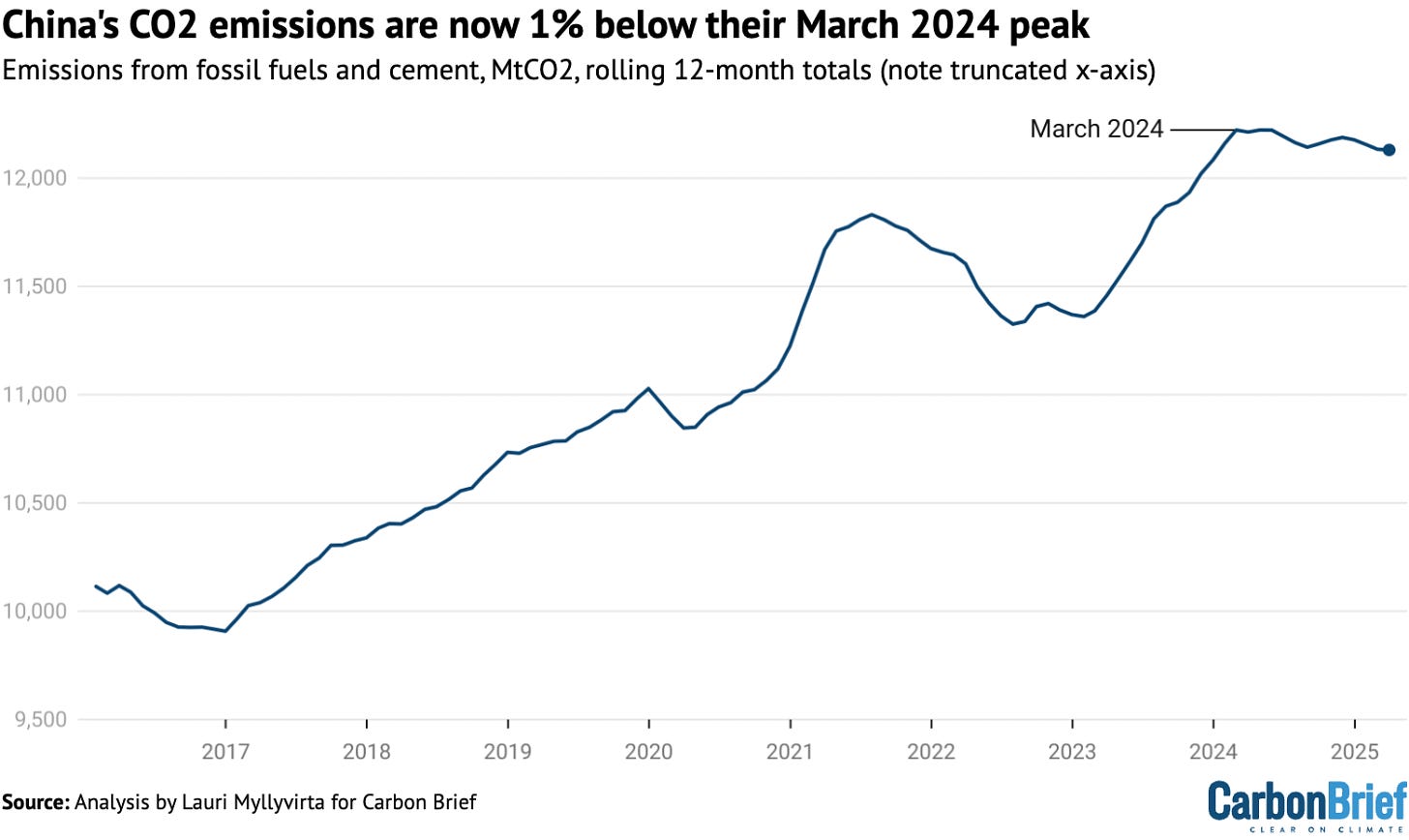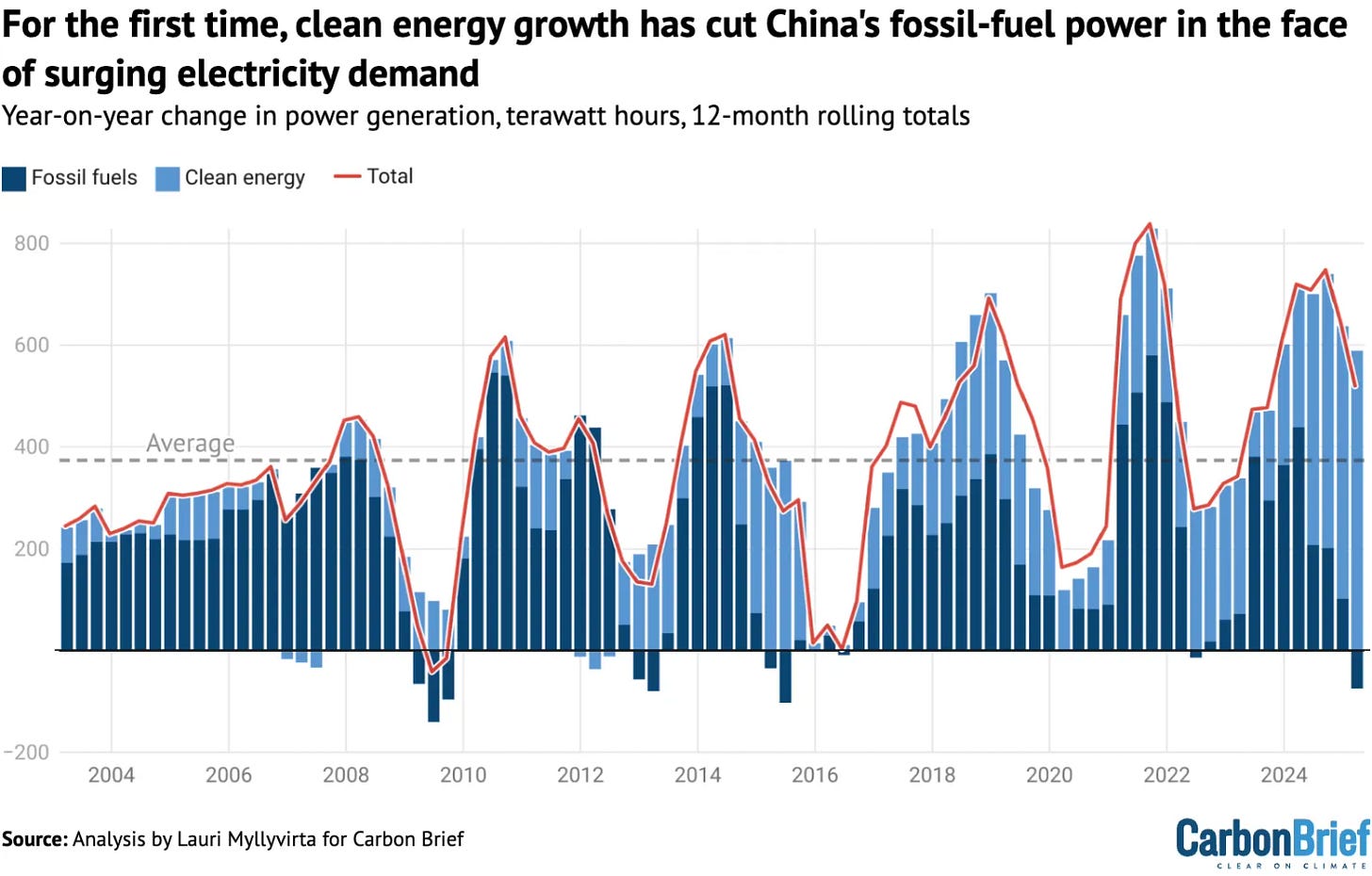China's CO2 Flow Drops Despite Growing Electricity Demand
Wind, solar and nuclear growth appears to be driving a big shift (for now).
The challenge is borderline existential for anyone seeking to accelerate expansion of clean-energy alternatives in the face of Trump’s assault on all things climate and the “big beautiful bill” being crafted by his minions in Congress. To keep track of the threats to the Inflation Reduction Act, I encourage you to sign up at Heatmap.news, where Robinson Meyer and his team have been doing nonstop coverage:
It’s easy to feel overwhelmed. One tonic is to widen your view.
Below I’m pointing to one encouraging data point from China reported by the folks at Carbon Brief, which is a valuable guide to climate and energy trends.
As I’ve noted for many years, whatever happens with greenhouse gas emissions in the United States matters, but is largely swamped by what happens in China and India and, ultimately, many other developing countries with fossil resources.
Click back to An Energy Transition Reality Check with McKinsey’s Mekala Krishnan and A Michael Liebreich Reality Check on "Net Zero," Trump's "Energy Emergency" and more for more on the overall picture.
Despite the damage Trump et al are doing to American clean-energy efforts, Trump cannot magically wave his Sharpie and wreck the global climate.
Here’s the opening of the Carbon Brief update, written by Lauri Myllyvirta, lead analyst at the Centre for Research on Energy and Clean Air and senior fellow at Asia Society Policy Institute:
For the first time, the growth in China’s clean power generation has caused the nation’s carbon dioxide (CO2) emissions to fall despite rapid power demand growth.
The new analysis for Carbon Brief shows that China’s emissions were down 1.6% year-on-year in the first quarter of 2025 and by 1% in the latest 12 months.

Electricity supply from new wind, solar and nuclear capacity was enough to cut coal-power output even as demand surged, whereas previous falls were due to weak growth.
The analysis, based on official figures and commercial data, shows that China’s CO2 emissions have now been stable, or falling, for more than a year.
However, they remain only 1% below the latest peak, implying that any short-term jump could cause China’s CO2 emissions to rise to a new record.
Other key findings include:
Growth in clean power generation has now overtaken the current and long-term average growth in electricity demand, pushing down fossil fuel use.
Power-sector emissions fell 2% year-on-year in the 12 months to March 2025.
If this pattern is sustained, then it would herald a peak and sustained decline in China’s power-sector emissions.
The trade “war” initiated by US president Donald Trump has prompted renewed efforts to shift China’s economy towards domestic consumption, rather than exports.
A new pricing policy for renewables has caused a rush to install before it takes effect.
There is a growing gap that would need to be bridged if China is to meet the 2030 emissions targets it pledged under the Paris Agreement.
If sustained, the drop in power-sector CO2 as a result of clean-energy growth could presage the sort of structural decline in emissions anticipated in previous analysis for Carbon Brief.
The trend of falling power-sector emissions is likely to continue in 2025.
However, the outlook beyond that depends strongly on the clean energy and emissions targets set in China’s next five-year plan, due to be published next year, as well as the economic policy response to the Trump administration’s hostile trade policy. [Read the rest.]

In January, Jesse Jenkins of Princeton and Robinson Meyer hosted Lauri Myllyvirta on their Shift Key podcast exploring if China’s emissions have already peaked:
And you can follow Myllyvirta’s work at the Center here:







Julio Friedmann, who closely tracks carbon trends, sent these thoughts by email:
Thanks for sharing this and thank for the ask.
Hard to know, for many reasons. The official numbers often get revised upwards. A hot summer could change the mix, etc.
This kind of structural decline is long anticipated and inevitable. Could be this is finally it.
Probably too early to say - we've been unduly optimistic in the past - even when 3-year plateaus gave hope. I'm personally optimistic, but that matters little.
Gotta watch the topline number - total emissions - since so much of China's emissions are from heavy manufacturing, and that's harder to predict. Again, good reasons to believe that overcapacity, global schisms, etc. could lead to real reduction, but it's too early to call.
As you rightly point out, these data are VERY far away from rapid or profound reductions. The big natgas pipelines are about to come on line from central Asia. Decoalificaiton will require more than marginal displacement of coal by renewable energy.
Punchline: Don't know, won't say. Grounds for optimism in structural changes, but we've said that before as well.
My $0.02 worth.